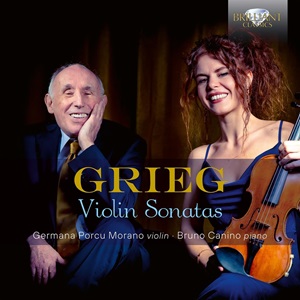
Edvard Hagerup Grieg (1843-1907)
Violin Sonatas
Sonata No 1 in F major, Op 8 (1865)
Sonata No 2 in G major, Op 13 (1867)
Sonata No 3 in C minor, Op 45 (1886)
Germana Porcu Morano (violin), Bruno Canino (piano)
rec. 2022, BartokStudio, Bernareggio, Italy
Brilliant Classics 96949 [72]
Grieg completed only five chamber works: these three violin sonatas, the Cello Sonata Op 36 and the String Quartet Op 27. A second string quartet was completed from Grieg’s sketches by Julius Röntgen and should be heard in this form. He was pleased with these violin sonatas and considered them among the best of his works. That is not surprising: they are indeed delightful pieces, as much fun to play, I would imagine, as to hear. Incidentally, the first two predate Brahms’s violin sonatas, of which they might otherwise remind the listener. They are all in three movements, with the middle movement in each case an Allegretto rather than a true slow movement.
The first sonata was written when the composer was twenty-two. He had studied in Leipzig and learned his way round classical sonata form. The first and last movements of this first sonata are both in sonata form, while the middle one is a minuet and trio. The themes are attractive and varied and the mood is generally cheerful, with a darker note sounded in the first movement development.
Grieg wrote the second sonata in three weeks during his honeymoon, and it is considered the most Norwegian of the three. Grieg was close to his uncle, the violinist and composer Ole Bull. He was also familiar with Norwegian folk music and with its characteristic instrument, the Hardanger fiddle. In addition to the four strings of the normal violin, the Hardanger fiddle has four or five extra sympathetic strings, which are not played but resound according to what is being played on the four playing strings. There are other differences too. The instrument is typically used to play dance music at weddings. Grieg clearly had the sound of this in his ear while composing this work. This sonata is known as the Dance Sonata and there are dance rhythms in the outer movements. The second movement, however, is more Chopinesque.
The final sonata comes from twenty years later and was Grieg’s last chamber work. This is the best known of these three works and it is the most dramatic. It is the only one in a minor key, and I feel some affinities with Brahms’s slightly later D minor violin sonata. It also has some very characteristic themes, which are of the kind that you feel you have known all your life. It also has some adventurous harmonies and sudden changes of mood, particularly in the middle movement.
Germana Morano, the violinist here, has won several competitions and has a flourishing career, as a soloist, chamber and orchestral musician. She plays fluently and well, with a lustrous and gleaming tone which she can darken as needed for the occasional more sombre passages. Her partner is the veteran Bruno Canino, probably better known for his many recordings of chamber music than for solo recitals, though he has recorded these too. They make a good team, responsive to the varying moods of the music and to each other. The recording is a trifle close but very acceptable. The sleeve note is very informative, including music examples.
There are numerous recordings of the three Grieg violin sonatas, as well as some of just the third with other works. I suppose the front-runner is probably still Augustin Dumay with Maria João Pires on DG, though that is now over thirty years old. A personal favourite is Hagai Shaham with Arnon Erez on Hyperion, which also has some smaller pieces added. However, the DG is now only available as a download and the Hyperion is still full price, whereas this newcomer is at Brilliant Classics’ bargain price. Anyone who chooses it will be well satisfied.
Stephen Barber
Help us financially by purchasing from




















